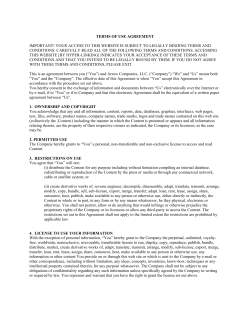
Environmental Economic Theory No. 2
Professional Career Program Environmental Economic Theory No. 8 Decentralized policies: Liability laws, property rights, voluntary action. Instructor: Eiji HOSODA Textbook: Barry .C. Field & Martha K. Fields (2009) Environmental Economics - an introduction, McGraw-Hill, International Edition 1 PCP Environmental Economic Theory (Hosoda) Homework 9 16 December 2014 • Theme: Choose any pollution which occurred in your country in the past, say, water pollution, air pollution, soil pollution etc, and explain how the government or communities tried to solve the problem, whether the result is acceptable or not. • Language: English. • Volume: A4 one page or two. Single space. 10.5 points. • Submission period: 9 a.m. 21 December – 23 a.m. 16 December 2014. • Submission: Submit your paper in a pdf. file. A file name must be “HW9.xxx.pdf” (xxx=your name). Send your file to hosoda@econ.keio.ac.jp. • Remark: Sources other than internet documents are recommendable. If you use internet information, check plural sources and compare them. List references you have used. Keep a electronic photocopy of the original essay for yourself. 2 The purpose of this chapter In this chapter, we study decentralized policies represented by (1) liability laws (rules), (2) property rights and (3) voluntary action. Decentralized policies allow the individuals involved in a case of environmental pollution to work it out themselves. 3 1. Liability Laws (rules) • Liability and compensation are important concepts in daily economic activities. • Actors are sometimes liable for damages which they have caused. • They are often required to compensate those damages. • By liability laws, would-be polluters make careful decisions, and may internalize external effects. 4 Liability Laws (rules)(cont.) • Suppose that your activity such as discharge of waste water, gas and so on may possibly cause damages to others, and are supposed to compensate for those damages, following liability laws. • Then, you become very careful for the discharge, trying to avoid bringing about the damages. 5 Principle: Explanation by means of a figure If a polluter is liable for the damages which he/she has caused, MD he/she must compensate the amount represented by the area (b + c + d). r MAC d a b O If the liability rule is given, a would-be polluter should choose e*. (Consider why so.) Notice that some damages (b) remain. c e* Emissions e1 Yet, whether this actually happens depends upon the legal process. 6 Two types of laws • Common law: (Judge-declared law). Law which exists and applies to a group on the basis of customs and legal precedents developed over hundreds of years in Britain. • Statutory law: This is a written law passed by legislature on the state or federal level. • Let us consider them in order. 7 Common law • Common-law systems rely on court proceedings in which plaintiffs and defendants meet to make claims and counterclaims, and in which juries are often called on to decide questions of fact and amounts of compensation. • Common-law systems are adopted mainly in United Kingdom, USA, and so on. • Basically, they are not adopted in Japan, but the similar procedure has partly been introduced into Japanese courtrooms for some specific 8 cases. Common Law: Strict liability and negligence • Strict liability holds polluters responsible for damages regardless of circumstances, whether there is negligence or not. • Non-strict liability (negligence liability) holds polluters responsible for damages only if they do not take appropriate steps to avoid the damage. • Can the optimal emission level e* in the figure be attained in common law procedures? • Yes, at least in theory, but things are more complicated in daily life. 9 Common Law: Joint and several liability and non-joint liability • Joint and several liability: One party can be held liable for all of the damages stemming from a collective act of pollution. • Non-joint liability: A party will be held liable only for its portion of the total. • Which type of liability should be adopted depends upon history, culture, legal mindset, 10 circumstances and so on. Common Law: Burden of proof and standards • It does matter which side a burden of proof is on. • Usually, a plaintiff who is damaged is required to prove causal relationships which show that he/she is really damaged by the defendant’s action. • If rigorous or scientific causal relationships are required to be shown by a plaintiff, the burden of proof is too heavy. • As for environmental issues, epidemiologic relationships are considered sufficient as causal relationships. 11 Remark • Epidemiologic relationships is not the same as scientific causal relationship. • According to Wikipedia, epidemiology is the study (or the science of the study) of the patterns, causes, and effects of health and disease conditions in defined population. • Even if a causal relationship cannot be found between two events, epidemiologic relationship may be considered to exist between them if the probability that one event causes the other is high. 12 Common Law: Transactions costs • Transactions costs are the costs of reaching and enforcing agreements. • The concept was first introduced in economics to apply to the costs that buyers and sellers encounter in making a successful transaction. • The costs include searching costs, bargaining costs, agreement costs and so on. 13 Common Law: Transactions costs (cont.) • The concept is applied to liability systems. • In this case, the transactions costs are those related to gathering evidences, presenting a case, challenging opponents, and so on. • In many cases of environmental problems, the transactions costs are often very large. 14 Statutory law • Many countries have introduced liability laws which control pollution issues. • Particularly when it is hard to monitor polluters’ behavior, liability provisions may give them an incentive to undertake the appropriate steps to reduce the probability of accidents. • In Japan, the law for the compensation of pollutionrelated health injury was introduced in 1973. • The statutory laws can provide the correct incentives only if the compensatory payments required from each polluter approach the actual amounts of damage they cause. 15 2. Property Rights • External diseconomies have a reciprocal nature. • It is sometimes difficult to determine which side gives external diseconomies. • This problems is closely related to allocation of property rights. • Once property rights are properly allocated among economic actors, environmental problems may possibly be solved by negotiation. • Yet, property rights are often imperfectly specified in the case of environmental assets. 16 External diseconomies which have a reciprocal nature • Person A may have right to enjoy quietness. • Person B may have right to enjoy music at full blast. • In the former case, the quietness may possibly be imposed on person B, while the big sound may possibly be imposed on person A in the latter case. • Which gives an external effect to which? 17 Principle: The Coase theorem • The Coase theorem tells us that the optimal emission level is attained by voluntary negotiation of the involved actors, on whichever side the property rights may be assigned, provided that some conditions are fulfilled. • This theorem is remarkable since it insists that the initial allocation of property rights does not affect the optimal allocation. 18 Principle: The conditions on which the Coase theorem holds 1. Property rights are defined well and defensible. 2. Transactions costs are reasonably low. 3. There exist markets through which the owners can actually realize the full social values of their decisions. 4. There is no income effect. 19 Principle: Explanation by means of a figure r MAC d a b O Suppose that the emission rights are given to a plant MD which emits pollutants. Negotiation between the plant and the damaged actor leads the emission level from e1 to e*. The latter actor compensates for the reduction of pollutants. (Consider why so.) c e* Emissions e1 From which points the negotiation starts, the final result is obtained at e*. If the clean environmental rights are given to the latter actor, the negotiation leads the emission level from O to e*. In this case, the plant compensates for the damage from which the latter actor suffers. .(Consider why so.) 20 Transactions costs may be large • In the simple case explained by the figure, transactions costs would probably be low. • Yet, in some cases, those costs may be huge. • Suppose there are many actors who are damaged by pollution. Then, it is usually hard for them to exchange opinions and to take the case to a court in a cooperative manner. (→Erin Brockovich!) • Moreover, there may be free-riders. • Hence, high transactions costs will reduce the potential of private property approach. 21 Erin Brockovich Real Evin Brockvich 22 Erin Brockvich in the movie Absence of markets • A property rights approach requires market valuation or its alternative way of valuation. • Without any valuation of related factors, negotiations cannot take necessary values into account. • Environmental assets, however, have a nature of public goods, and all the values may not be considered by actors involved in negotiations. • Public actors may well create the demand side 23 for such a market. A few important remarks • The strongest feature of a property rights system is that it gives owners the incentive to protect and manage their assets to maximize their market value. • Negotiations between two actors usually succeed in efficient allocation of environmental resources, provided that the above four conditions (upon which the Coarse Theorem holds) are satisfied. 24 A few important remarks (cont.) • In reality, it is sometimes hard to determine the allocation of property right. • In the pollution cases which appeared in the 1970s, polluters vaguely thought that they had the right to pollute the environment. • Yet, in the courts, such right was rejected. • This implies that people have the right to enjoy clean environment, although the environment right has not been stipulated so far. 25 Markets for Green Goods • Once property rights are established, new private markets might be formed that could move the economy toward improved environmental quality. • Among citizenry at large there is steadily growing concern about the impacts of environmental pollution. • This represents an opportunity for private entrepreneurs to make available goods and services that are produced in more environmentally benign ways. 26 Markets for Green Goods (cont.) Suppose that a demand curve for green electricity is expressed DG. Then, the price of green electricity is pG1 in a market equilibrium, and the amount of qG1 is transacted. If technical progress occurs for green electricity and the supply curve shifts down to SG2, the price falls down to pG2. If the price of green electricity falls down, demand for dirty electricity will shrink and the demand curve shifts, say, from DF1 to DF2, since green electricity and dirty electricity are substitutes for each other. The price of dirty electricity falls down also, and the amount of dirty electricity is reduced. DF2 DF1 SG1 DG SF0 SG2 pG1 pF1 pF2 pG2 qG1 qG2 qF2 qF1 27 3. Voluntary action • One might consider that voluntary action is not useful for pollution control. • Actually, voluntary action is sometimes effective for pollution control or environmental conservation programs. • But, why do private sectors try to control pollution voluntarily, without governmental intervention? • There are two reasons: moral suasion and informal community pressure. 28 Moral suasion • Moral suasion may encourage people to act in an environmental friendly manner. • Local communities proceed with recycling activities voluntarily. Green people persuade non-green people for recycling. • Moral suasion has widespread spillover effects. • We cannot rely very heavily on moral suasion to control pollution, but it creates a strong atmosphere in which environmental policies are more easily administered and enforced. 29 Informal community pressure • Informal community pressure may give incentive to would-be polluters to reduce the amount of pollutants emission. • If firms dare to counter the community pressure, they may loose their social reputation, which means the loss of the long-run profits. • Also, their stock values may possibly decline, and there may be financial damages. Stockholders should not be happy with this. 30 Remark: importance of information • A major factor in voluntary actions is disclosure of information on firms’ environmental performances. • Unless there is such information, it will be difficult to mobilize public concern on the responsible parties. • TRI (Toxic Release Inventory) program may work in this direction. ⇒PRTR (Pollutant Release and Transfer Register) in Japan. 31 Remark (cont.) • CSR (Cooperate Social Responsibility) is also considered to work as one of the voluntary actions. • Nowadays, many firms publish CSR reports, which contain so-called negative information. • SRI (Socially Responsible Investment) gives financial momentum towards voluntary actions. 32 Remark (cont.): CSR STOCKHOLDER SRI CSR Corporate Citizenship Philanthropy Environmental Management Others STAKEHOLDER 33 CSV • A famous Harvard professor Michael Porter proposes CSV (Creating Shared Value), instead of CSR. • CSV is a more positive concept than CSR. • CSV will surely contribute to enhancing environmental quality. 34
© Copyright 2024










